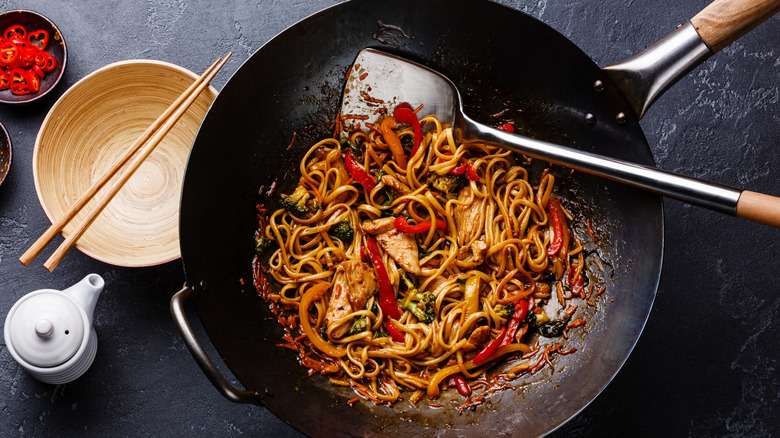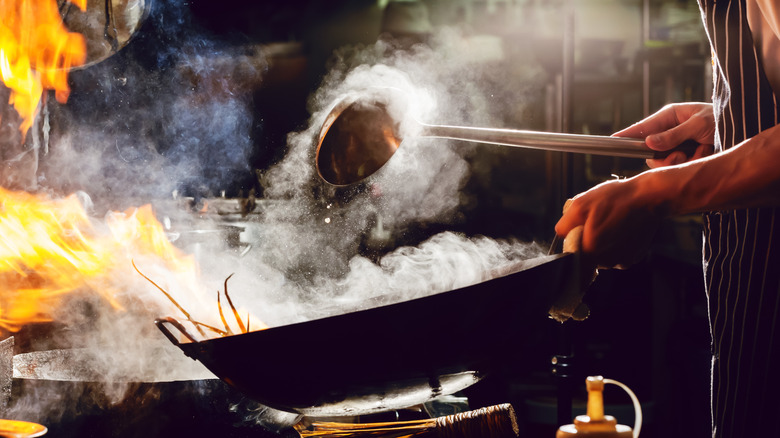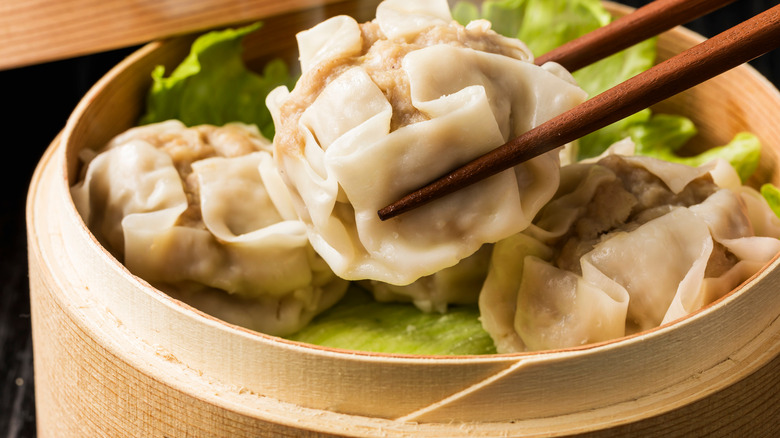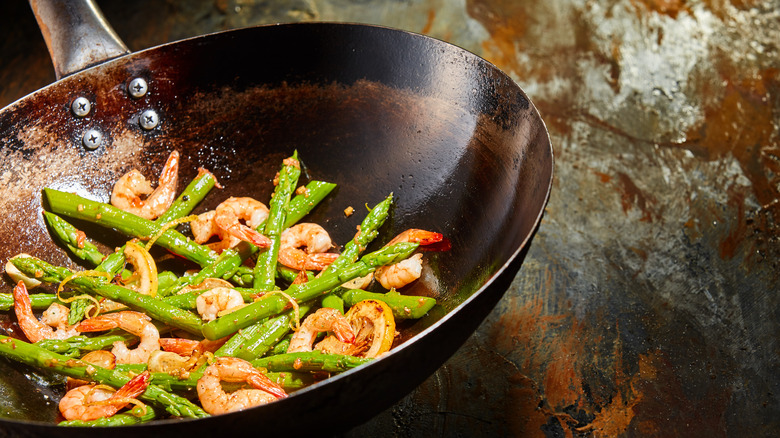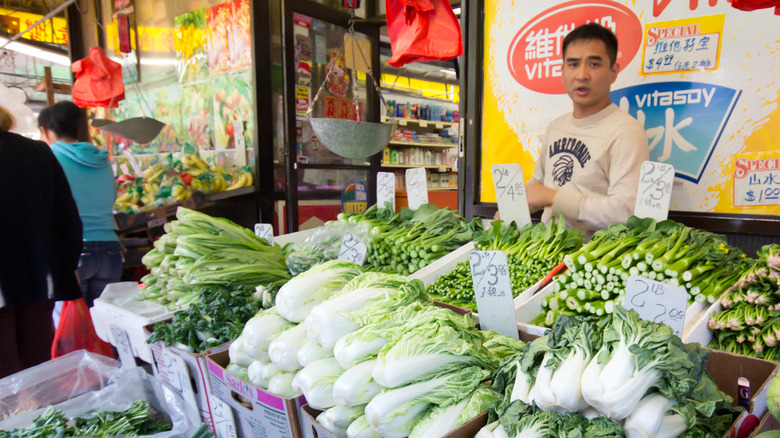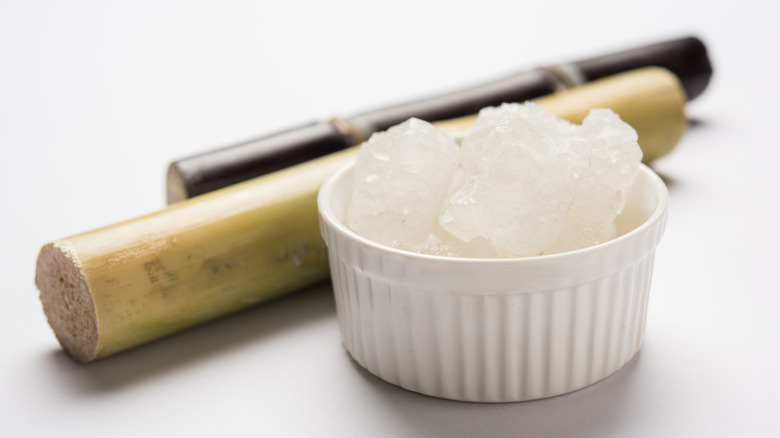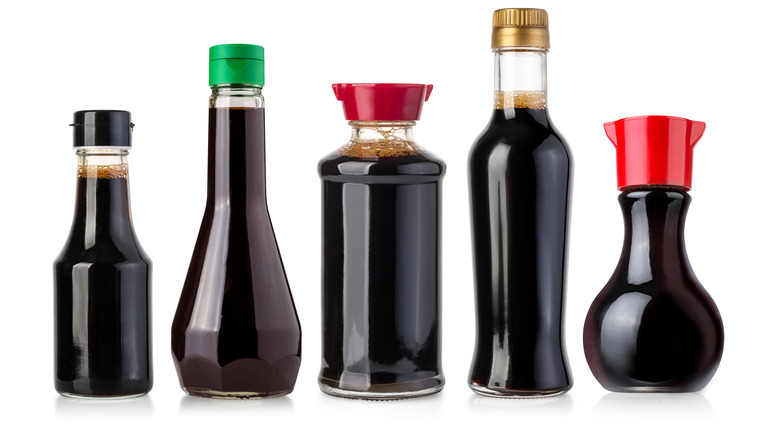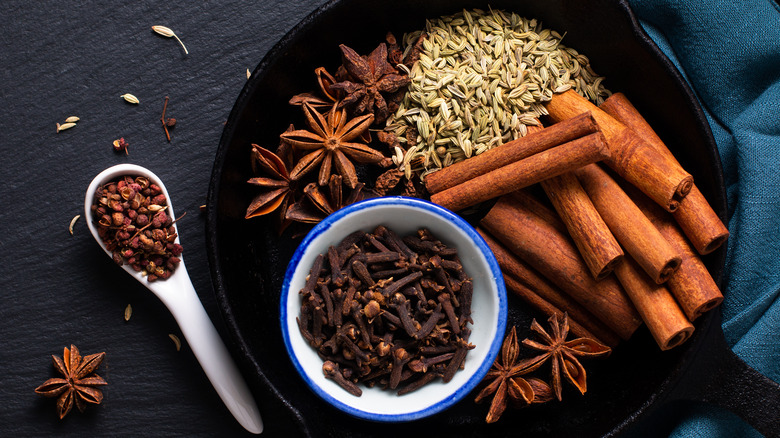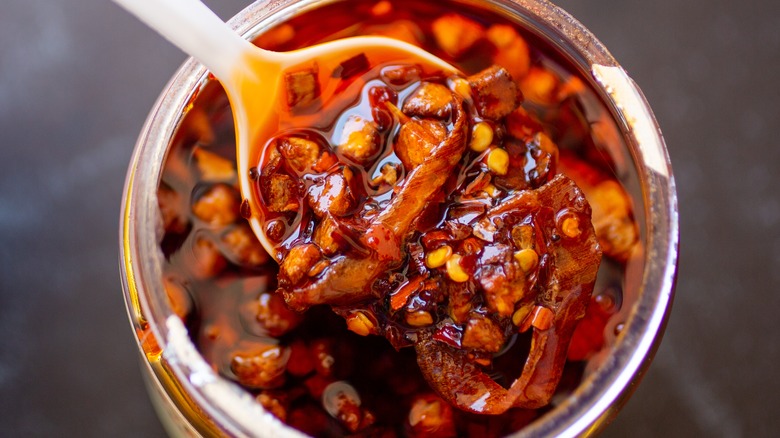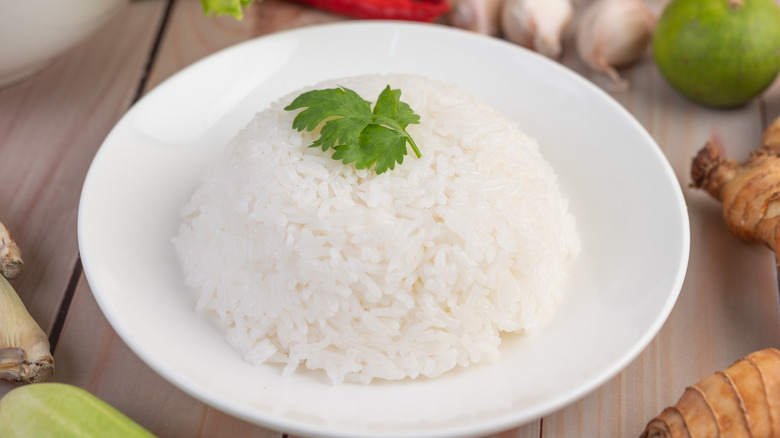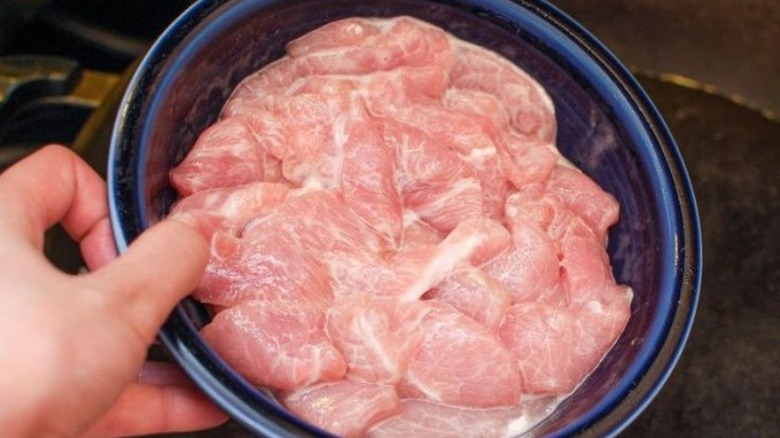Why Chinese Food Always Tastes Better At A Restaurant
We may receive a commission on purchases made from links.
The Chinese food that you get in Chinese restaurants may seem simple, but trying to make the same dishes at home often yields disappointing results. Most of what you're doing incorrectly at home boils down to using the wrong ingredients, tools, and cooking methods. You're using Japanese soy sauce instead of Chinese soy sauce, your stir-fry method needs a lot of help, and your Uncle Ben's rice just isn't cutting it. Not only do you need to make a trip to your local Asian market to stock up on real Chinese ingredients, but you also need a proper wok and a few lessons in Chinese cooking techniques. Once you've learned to velvet your meat, achieve wok hei (or something close), and add a few new spices and sauces to your pantry, you'll find that the Chinese food you cook at home will start to taste a little closer to what you get in a Chinese restaurant.
You're using the wrong sauces
Most people only have a few Chinese sauces in their pantries when attempting to make Chinese food at home. The wife of a Chinese restaurant owner said that he was always perplexed by the "1000 different bottles and jars" of sauces his wife used in her restaurant. Maybe 1000 sauces is an exaggeration, but he says, "She has a range of about 10 different soy sauces for different dishes, many different oyster sauces, black bean sauces, [and] vinegars of all sorts" (via Quora).
Other Chinese sauces you might need include fish sauce, shrimp paste, XO sauce, hoisin sauce, sweet bean sauce, bean paste, fermented black beans, chili garlic sauce, sesame sauce, or plum sauce. Shaoxing wine, rice wine, or black vinegar will also make Chinese dishes taste more authentic (via The Woks of Life).
Not all Chinese sauces are of the same quality. For example, when you look at popular soy sauces that you might encounter at the grocery store, some (like La Choy) barely even qualify as soy sauce. Chemical soy sauces are made from ingredients like hydrolyzed soy protein rather than fermented or brewed soybeans (via The Woks of Life). Shopping for Chinese sauces at an Asian market is usually your best bet for authentic sauces.
You aren't adding MSG
MSG (monosodium glutamate) is an ingredient that Chinese restaurants commonly add to their foods to give them a deeper flavor. There's a myth that MSG in Chinese food causes all sorts of physical problems, ranging from headaches to numbness and chest pains. However, researchers haven't found a clear link between MSG and these symptoms (via Mayo Clinic). So you might consider MSG as a possibility for bringing more flavor to your home Chinese cooking.
The Japanese chemistry professor who first created MSG, Kikunae Ikeda, discovered it in his search for a fifth flavor beyond sweet, salty, sour, and bitter. We now know this flavor as "umami" (via The University of Tokyo). According to the FDA, MSG is the "sodium salt of the common amino acid glutamic acid."
MSG actually occurs naturally in some umami-rich foods we eat regularly, like tomatoes and cheese. So, while it has a chemical-sounding name, MSG is not unnatural, and the FDA considers it "generally recognized as safe" (GRAS). Most commercially-available MSG comes from fermenting starches or sugars like sugar beets or sugar cane. The fermentation process for making MSG is similar to the process for making wine and vinegar. Our bodies metabolize MSG the same way they metabolize the chemical when it occurs in food naturally.
You aren't achieving wok hei
The flavors of authentic Cantonese stir-fries are achieved through "wok hei." Wok hei translates to "breath of a wok" and presents itself in the smoky flavor that comes from using a searingly hot wok (via Michelin). The smoky flavor comes through the caramelization of the foods' sugars through the Maillard reaction, which doesn't occur until the food reaches temperatures that aren't possible with an ordinary home stovetop (via Michelin).
To accomplish wok hei, it's essential to wait until your hot wok begins to smoke before adding oil. That way the food won't stick and it will taste smoky. It's also necessary to avoid crowding the wok and to toss the ingredients nonstop so they don't end up steaming instead of browning. Some exceptional Chinese chefs even allow the cooking flames to enter their wok as part of the cooking process.
Cooking enthusiast Ming Liu says that typical home stoves are only rated at about 5000 BTUs, whereas the stoves in commercial Chinese restaurant kitchen are around 15K BTUs. To use a commercial stove at home that can reach temperatures high enough for achieving wok hei, you'd also need an industrial-level venting system. Other higher-BTU stoves are for outdoor cooking, like camp stoves (30K BTUs), fryers (90K-150K BTUs), or brewer burners (50K BTUs), according to Quora.
You don't have enough experience with Chinese cooking techniques
Western cooks are familiar with Chinese cooking methods like frying, boiling, braising, and roasting. However, its other, less-familiar cooking methods like stir-frying, steaming, and red stewing can throw us for a loop because they're not a part of our normal cooking technique repertoire (via China Highlights).
Stir-frying at home can be tricky because it's impossible to reach the temperatures on standard home stoves that professional Chinese chefs can. We commonly make stir-fry mistakes like overcrowding our woks and not having the wrist strength to continually toss the ingredients; we may end up with steamed rather than truly stir-fried veggies (via Michelin). Chef Jeremy Pang says that stirring ingredients, adding cold ingredients to the wok, and even flipping the wok too much can cool the wok down when it's important to keep it as hot as possible (via MyLondon).
One of the biggest mistakes we make when we steam foods is overcrowding the steamer. Chinese cooks often use stacked bamboo steamers to be able to cook more food at a time.
Red stewing (or red cooking) is a technique Chinese cooks use to soften tough meat cuts. The meat cooks for several hours in a sauce made from soy sauce, sugar, wine, broth, and spices. You either start out blanching or browning the meat before braising it in the simmering sauce (via Gourmet Traveler).
You don't own a good, seasoned wok
If you're trying to stir-fry vegetables in anything other than a wok, you won't get results even close to what you find in a Chinese restaurant. When picking out a wok to use, the best type is made of carbon steel with a long handle on one side and a helper handle on the other side to assist with flipping the wok ingredients (via The Woks of Life).
You should be sure to season your wok to help create a nonstick cooking surface for your stir-fry. Some people mistakenly think that seasoning means they shouldn't scrub their wok clean after each use. However, you want to build the patina naturally, over years of gentle seasoning; it shouldn't be from old food.
According to The Woks of Life, after you buy a new carbon steel wok you should wash it with soapy water. Then place it over high heat until it starts smoking and turning dark, tilting it toward the heat to darken the whole surface. After it's cooled down for a minute, you'll add about a cup of hot water to the wok before washing it with soap and water at the sink. Dry it on the stove on medium-high heat before lowering the heat and adding about a tablespoon of vegetable oil. Then wipe the oil around the wok with a paper towel and heat until smoking. You should repeat the washing and oiling process every time you use your wok.
You're not shopping for your ingredients at an Asian market
The typical major American chain grocery store – even those with a good-sized Asian section – won't have the ingredients necessary for restaurant-level Chinese food. To find the authentic Chinese sauces, spices, noodles, and other ingredients you need, you'll want to locate an Asian grocery store.
Since many vegetables in the produce section and products on the shelves may not have English labels, if you do not know Chinese, you may want to do a little research ahead of time to know what the different vegetables or popular product brands look like. Otherwise, you can use apps on your phone to help. Taking a photo with Google Lens can help you identify unfamiliar produce, while the camera function in Google Translate can assist with reading Chinese labels. Neither of these provides 100% accurate results, but if you don't have a friend who is familiar with Chinese cooking ingredients to go with you to the store, it can prevent you from being overwhelmed. Of course, you can always ask someone who works at the store for help, which is a far more efficient method than relying on phone apps.
You're not adding they right type of sugar
Chinese cooks use some types of sugar that may be familiar, like white granulated sugar, brown sugar, and molasses. However, others may not be as familiar. For example, Chinese cooks use Chinese brown sugar, Chinese rock sugar, palm sugar, coconut sugar, maltose, and jiuniang (sometimes translated to "rice sauce").
Chinese brown sugar (sometimes called "black sugar") has different flavor profiles depending on the region where it's grown. Chinese rock sugar isn't quite as sweet and overwhelming to the tastebuds as regular white sugar and comes in a variety of forms, including polycrystalline rock sugar, monocrystalline rock sugar, and brown rock sugar bars. Rock sugar helps provide a shiny appearance and delicate flavor for braised meat and a delicate sweetness to drinks. Palm sugar and coconut palm sugar can substitute for Chinese brown sugar in recipes. Palm sugar has a lower glycemic index than many other sweeteners. Maltose is 30% sweeter than ordinary sugar and is often used in Chinese confectionaries or to provide a high-gloss shine to meats without being sticky. Jiuniang is a fermented rice and yeast sweetener that Chinese cooks often use for soup desserts, or that may be used as a sweet flavoring in Sichuan recipes.
You're not buying your seafood fresh
Even if you don't live anywhere near the ocean, it's possible to use fresh seafood in your Chinese dishes. The longer that seafood is dead, the more bacteria it acquires, which may give it a fishy taste and smell (via American Society for Nutrition). So it's important to find a fish market with fresh seafood for your Chinese dishes.
If you live hours from the coast, you'll want to find a source that flies in fresh seafood or keeps seafood fresh in tanks. Often, some of the freshest fish in your city will be at an Asian market. In fact, many times, you can choose from a variety of tanks of live fish on the premises. However, you will want to avoid purchasing fish from tanks with a number of dead fish in the water (via Times Union). Many fish markets smell fishy because of the sheer amount of fish they process daily. However, the important thing is that the seafood you buy is fresh so you can have the best-tasting Chinese seafood dish possible.
You're not using the right type of soy sauce
Different soy sauces have different uses and flavor profiles. Regular soy sauce works for most types of cooking to help deepen the umami flavor and saltiness of any dish. You're more likely to encounter dark and light soy sauce in Cantonese cooking. Dark soy sauce belongs in braises or adds color and strong and salty flavor, while light soy sauces are more appropriate for dishes that need to stay light in color. South Central Chinese cooks are the most likely to use sweet soy sauce, which includes caramelized sugar and spices. Some serious Chinese cooks use finishing soy sauces to add an interesting final flavor layer (often sweet) at the end of cooking (via Eater). Other types of Chinese soy sauces you may encounter include mushroom-flavored dark soy sauce, double black soy sauce (dark soy sauce made with molasses), and seasoned soy sauce (usually labeled for the type of food it accompanies best), according to The Woks of Life.
Keep in mind that if you're using Japanese or Thai soy sauce for your Chinese food, you're not going to end up with a dish that tastes the same as one made with Chinese soy sauce. So, if you've always defaulted to a Japanese soy sauce like Kikkoman, that's one reason your Chinese food doesn't taste right. And if you've been using a chemical-based rather than soybean-based soy sauce like La Choy, it's certainly not going to taste as it should.
You don't have the right spices for Chinese food
If you visit an authentic Chinese restaurant, even cooks with the most attuned palettes may not be able to guess which spices created the most memorable flavors. Five-spice powder contains common spices like cloves and cinnamon, but it also contains star anise, fennel, and Szechuan peppercorns. Sichuan peppercorns leave your tongue feeling pleasantly numb and tingly, while star anise and fennel have licorice-like flavor notes. You might encounter doubanjiang (a spicy fermented bean paste) in dishes like mapo tofu (via Michigan State University Extension). Other spices may include specific types of chili flakes or powder, dried mandarin orange peels, coriander seeds, or cumin seeds. Chinese chefs often use three types of cardamom: black, green, and white. Curry powder features in some dishes. And, in addition to ginger and turmeric, Chinese restaurants sometimes use ginger and turmeric's relative, galangal (via The Woks of Life). And don't forget the MSG to add deeper, umami flavors to your food.
You're skimping on the fat and not using the right kind
If you're health-conscious, it's entirely possible that you're not using enough fat in your Chinese cooking to produce food as flavorful as you'll find in a Chinese restaurant. No two fats or oils taste the same, so the types of oils you choose can make a profound difference in how your home-cooked Chinese food tastes.
Different oils have different purposes in a Chinese restaurant. You should never use olive oil for Chinese food because it has such a low smoke point and doesn't go well with Chinese cuisine. Instead, you'll want to use oils with a high smoke point for frying, like peanut, corn, and coconut oil. Soybean and safflower oils are also common in Chinese cooking, but they can develop a fishy flavor (via Washington Post). Many home cooks overuse sesame oil when trying to mimic Chinese restaurant food at home. One Chinese restaurant secret is to use sesame oil for flavor rather than cooking. Using too much sesame oil or burning it can ruin your Chinese food (via The Woks of Life). Other oils you might encounter in Chinese cooking include lard, chili oil, or Sichuan pepper oil (via Quora).
You haven't mastered sticky rice
You may think you know how to cook rice, but do you know how to cook sticky rice? Cooking Chinese sticky rice is different than cooking some other types of rice with which you may be more familiar. Many Chinese restaurants use a rice cooker to make the process foolproof, but some make it on the stovetop instead.
Most Chinese restaurants use sticky rice, which is short-grained rice. You may see it labeled as "sweet rice" or "glutinous rice." If you use parboiled rice (like Uncle Ben's), you're not going to end up with the same flavor or texture.
If you don't have a rice cooker and plan to use a steaming basket, you should always soak your sticky rice before you cook it. You'll want to ensure that you cover the rice with at least three extra inches of water to account for expansion over the six to 24 hours you soak it (via The Woks of Life). While some rice cookers have programs for glutinous rice that don't require pre-soaking, some people still find that you end up with a better rice texture that's not too wet or sticky if you pre-soak your rice (via Tasty Thais). To ensure you've added enough water to your rice once it's in the rice cooker, you'll want to use the "knuckle method" to measure the water. Basically, the water should come to the line of your first knuckle (via Next Shark).
You're not velveting your meat
Velveting is a Chinese cooking technique that can help you achieve the most tender meat possible. According to Chinese chef Liu Ching Hai, "Other than locking in flavor, it also enhances the texture and fragrance of the finished dish" (via Michelin). It provides a protective coating for heat control, which helps to capture the smoky essence of "wok hei" in Chinese food you find in Chinese restaurants.
Liu says that there are a variety of ways to velvet meat. You start with a marinade of ingredients like soy sauce, rice wine, sugar, and seasonings like garlic. However, the most essential ingredients are starch flours (like potato starch or corn starch) or egg whites, which provide a protective coating to prevent the meat from overcooking and becoming tough.
According to Liu, you should marinate your meat for 10 minutes to an hour, depending on how tough the meat is. Then you'll par-cook the meat in oil or water until it's about 70% done. Frying the meat at temperatures between 140 and 160 F is the best choice for maintaining the taste of the marinade, but you can also try blanching it in boiling water. Then it's ready to add to your stir-fry.
